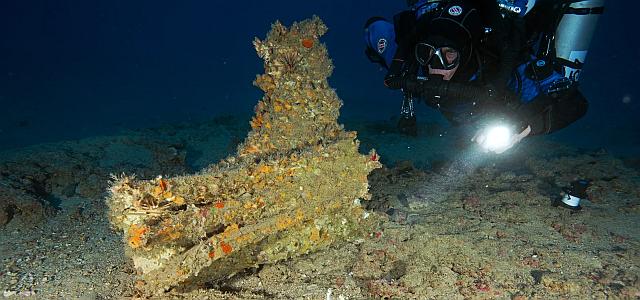 An intriguing account by the BBC of archeological serendipity that began with a trip to the dentist.
An intriguing account by the BBC of archeological serendipity that began with a trip to the dentist.
The Battle of the Aegates was a naval battle fought on 10 March 241 BC between the fleets of Carthage and Rome during the First Punic War. The Roman fleet’s victory ended the 23-year-long war and established Rome’s dominance over the Mediterranean, which would last for almost 700 years.
While the battle took place near the Aegates Islands, off the western coast of the island of Sicily, archaeologists had never located exactly where the battle took place. According to legend, the battle took place near Cala Rossa, a cove on the island of Favignana – the largest of the Aegadian Islands. Cala Rossa is so-called because of the intense color of the rocks, which were said to have been dyed by the blood of the Carthaginians who died in the battle. In reality, it is simply red algae that have colored the rocks. Researchers searching nearby found no trace of the battle.
In the early 2000s, the late archaeologist Sebastiano Tusa was visiting the home of a dental surgeon in the town of Trapani when he noticed a ram bow, the bronze beak of a Roman ship, known as a rostrum, on display. The dentist told him that it had come from a fisherman – who had paid for the work on his teeth with the ancient artifact. The dentist said that the rostrum had been discovered off the coast of Levanzo, an island to the north of Favignana.
Tusa suspected that it had originated from the famous Battle of the Aegates, inspiring Tusa and his colleagues to launch dedicated underwater archaeological expeditions in the sea around Levanzo, Sicily – with enormous success.
BBC reports that the team has so far discovered 25 fallen rostrums. James Goold, the chair of RPM Nautical Foundation notes that the wood has disintegrated, leaving only the bronze. Strangely, the divers have found that the hollowed-out insides are often filled with small objects such as coins. This, he says, is the work of octopuses, who have turned the rostrums into temporary dens. They have a magpie-like tendency to pick up treasure – and fill their homes with trinkets. “They are inveterate collectors,” he says. “They’ll take anything they can get their hands – or tentacles – on.”
Besides the bronze rostrums, the archaeologists have also uncovered around 40 helmets from both sides of the battle. “They are very evocative because each one could correspond to an identifiable person,” Goold told BBC Future as he showed us a map charting the finds. “We’ve saved sediment from inside some of the helmets to have it tested for DNA – because theoretically, it could have survived.” This could tell us a bit more about the kinds of people who were fighting.
The team also has uncovered large numbers of amphorae that will have carried food supplies and the tableware used by the shipmates, says Francesca Oliveri, a historian and archaeologist. “We are finding so many things that help to illustrate a little better the world of the 3rd Century BC,” she says. “It’s the first site of a naval battle, in the world, that has been scientifically documented like this, and it will continue to be documented – because the area of interest is very large… It will take at least another 20 years to explore it fully.”
Sadly, Sebastiano Tusa will not be able to see the final results of his research – and of his intuition. He died in the crash of the Ethiopian Airlines Flight 302 in 2019 while traveling to a Unesco conference. Eerily, the crash occurred on 10 March, commonly thought to be the anniversary of the Battle of the Aegates.
To read more about the exploration of the site of the Battle of the Aegates, click here.
Thanks to Mary Habstritt and Alaric Bond for contributing to this post.
